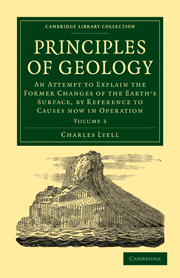 Principles of Geology
Principles of Geology Book contents
- Frontmatter
- PREFACE
- Contents
- LIST OF PLATES AND WOOD-CUTS IN THE THIRD VOLUME
- LIST OF WOOD-CUTS
- ERRATA
- CHAPTER I
- CHAPTER II
- CHAPTER III
- CHAPTER IV
- CHAPTER V
- CHAPTER VI
- CHAPTER VII
- CHAPTER VIII
- CHAPTER IX
- CHAPTER X
- CHAPTER XI
- CHAPTER XII
- CHAPTER XIII
- CHAPTER XIV
- CHAPTER XV
- CHAPTER XVI
- CHAPTER XVII
- CHAPTER XVIII
- CHAPTER XIX
- CHAPTER XX
- CHAPTER XXI
- CHAPTER XXII
- CHAPTER XXIII
- CHAPTER XXIV
- CHAPTER XXV
- CHAPTER XXVI
- Table I Showing the relations of the various classes of rocks, the Alluvial, the Aqueous, the Volcanic, and the Hypogene, of different periods
- Table II Showing the order of superposition of the principal European groups of sedimentary strata mentioned in this work
- Notes in explanation of the Tables of fossil shells in Appendix I
- Appendix I Tables of fossil shells by Monsieur G. P. Deshayes
- Appendix II Lists of fossil Shells chiefly collected by the author in Sicily and Italy, named by M. Deshayes
- Glossary, containing an explanation of geological and other scientific terms used in this work
- Index
- WORKS ON SCIENCE AND NATURAL HISTORY
- Plate section
- Frontmatter
- PREFACE
- Contents
- LIST OF PLATES AND WOOD-CUTS IN THE THIRD VOLUME
- LIST OF WOOD-CUTS
- ERRATA
- CHAPTER I
- CHAPTER II
- CHAPTER III
- CHAPTER IV
- CHAPTER V
- CHAPTER VI
- CHAPTER VII
- CHAPTER VIII
- CHAPTER IX
- CHAPTER X
- CHAPTER XI
- CHAPTER XII
- CHAPTER XIII
- CHAPTER XIV
- CHAPTER XV
- CHAPTER XVI
- CHAPTER XVII
- CHAPTER XVIII
- CHAPTER XIX
- CHAPTER XX
- CHAPTER XXI
- CHAPTER XXII
- CHAPTER XXIII
- CHAPTER XXIV
- CHAPTER XXV
- CHAPTER XXVI
- Table I Showing the relations of the various classes of rocks, the Alluvial, the Aqueous, the Volcanic, and the Hypogene, of different periods
- Table II Showing the order of superposition of the principal European groups of sedimentary strata mentioned in this work
- Notes in explanation of the Tables of fossil shells in Appendix I
- Appendix I Tables of fossil shells by Monsieur G. P. Deshayes
- Appendix II Lists of fossil Shells chiefly collected by the author in Sicily and Italy, named by M. Deshayes
- Glossary, containing an explanation of geological and other scientific terms used in this work
- Index
- WORKS ON SCIENCE AND NATURAL HISTORY
- Plate section
Summary
NEWER PLIOCENE FORMATIONS.
Having endeavoured, in the last chapter, to explain the principles on which the different tertiary formations may be arranged in chronological order, we shall now proceed to consider the newest division of formations, or that which we have named the newer Pliocene.
It may appear to some of our readers, that we reverse the natural order of historical research by thus describing, in the first place, the monuments of a period which immediately preceded our own era, and passing afterwards to the events of antecedent ages. But, in the present state of our science, this retrospective order of inquiry is the only one which can conduct us gradually from the known to the unknown, from the simple to the more complex phenomena. We have already explained our reasons for beginning this work with an examination, in the first two volumes, of the events of the recent epoch, from which the greater number of rules of interpretation in geology may be derived. The formations of the newer Pliocene period will be considered next in order, because these have undergone the least degree of alteration, both in position and internal structure, subsequently to their origin. They are monuments of which the characters are more easily deciphered than those belonging to more remote periods, for they have been less mutilated by the hand of time.
- Type
- Chapter
- Information
- Principles of GeologyAn Attempt to Explain the Former Changes of the Earth's Surface, by Reference to Causes now in Operation, pp. 62 - 74Publisher: Cambridge University PressPrint publication year: 2009First published in: 1833


